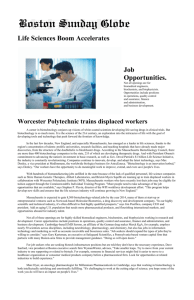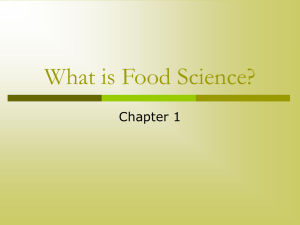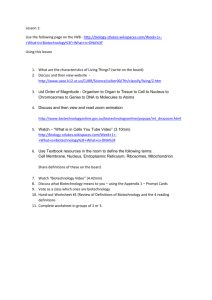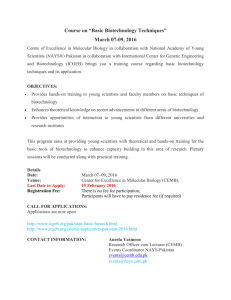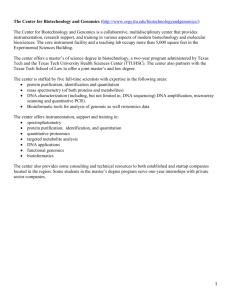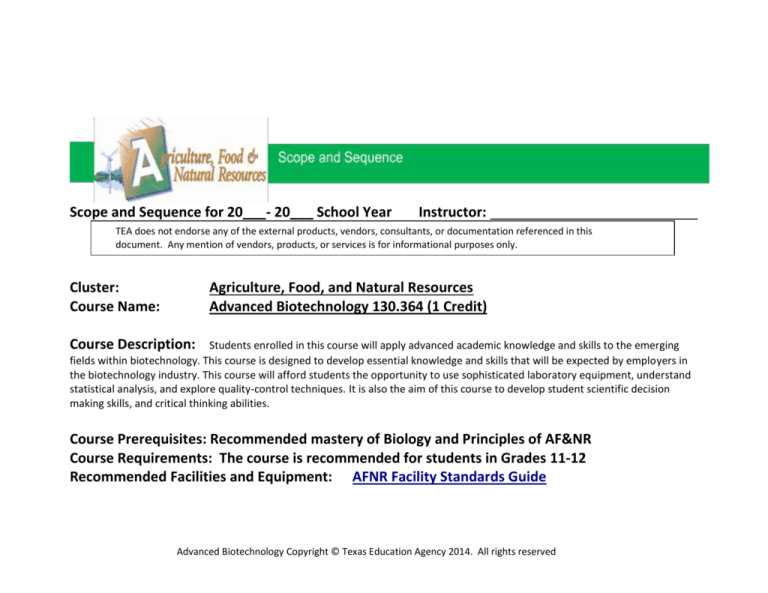
Scope and Sequence for 20___- 20___ School Year
Instructor:
TEA does not endorse any of the external products, vendors, consultants, or documentation referenced in this
document. Any mention of vendors, products, or services is for informational purposes only.
Cluster:
Course Name:
Agriculture, Food, and Natural Resources
Advanced Biotechnology 130.364 (1 Credit)
Course Description:
Students enrolled in this course will apply advanced academic knowledge and skills to the emerging
fields within biotechnology. This course is designed to develop essential knowledge and skills that will be expected by employers in
the biotechnology industry. This course will afford students the opportunity to use sophisticated laboratory equipment, understand
statistical analysis, and explore quality-control techniques. It is also the aim of this course to develop student scientific decision
making skills, and critical thinking abilities.
Course Prerequisites: Recommended mastery of Biology and Principles of AF&NR
Course Requirements: The course is recommended for students in Grades 11-12
Recommended Facilities and Equipment: AFNR Facility Standards Guide
Advanced Biotechnology Copyright © Texas Education Agency 2014. All rights reserved
Week
Number
TEKS Taught
Week 1
130.364c1A,B
Week 2
130.364c1C,D
Week 3
130.364c1E,F
Week 4
130.364c1G,H, I
Week 5
130.364c1J,K
Week 6
130.364c9A,B
Topic/Unit Title
The student, for at least 40% of instructional time, conducts laboratory and field
investigations using safe, environmentally appropriate, and ethical practices:
The student will demonstrate safe practices during laboratory and field investigations.
The student will demonstrate an understanding of the use and conservation of
resources and the proper disposal or recycling of materials.
The student, for at least 40% of instructional time, conducts laboratory and field
investigations using safe, environmentally appropriate, and ethical practices:
The student will demonstrate appropriate safety procedures, guidelines, and chemical
hygiene plan; the student will maintain required safety training, including location an
understanding of interpretation of material safety data sheets.
The student, for at least 40% of instructional time, conducts laboratory and field
investigations using safe, environmentally appropriate, and ethical practices:
The student will comply with federal and state safety regulations as specified by
Occupational Safety and Health Administration, and other regulatory agencies as
appropriate. The student will also be able to identify and obey safety symbols and signs.
The student, for at least 40% of instructional time, conducts laboratory and field
investigations using safe, environmentally appropriate, and ethical practices:
The student will maintain a clean and well organized work area, and dispose of
equipment, glassware, and biologics according to laboratory policies. The student will
be able to recognize common laboratory hazards.
The student, for at least 40% of instructional time, conducts laboratory and field
investigations using safe, environmentally appropriate, and ethical practices:
The student will observe procedures for the safe use of instruments, gas cylinders, and
chemicals. The student will be able to maintain safety and personal protection
equipment.
The student performs standard biotechnology laboratory procedures:
The student will operate laboratory equipment such as a microscope, thermocycler,
hood, pH meter, stirrers, balance, mixers, autoclave, power supply; practice measuring
volumes and weights to industry standards.
Advanced Biotechnology Copyright © Texas Education Agency 2014. All rights reserved
The student prepares solutions and reagents for the biotechnology laboratory:
The student will practice aseptic technique, prepare dispense, and monitor physical
properties of stock reagents, buffers, media, and solutions.
Week 7
130.364c9C
Week 8
130.364c9D,E
The student prepares solutions and reagents for the biotechnology laboratory:
The student calculates and prepares a dilution series, and determines acceptability and
optimum conditions of reagents for experimentation.
130.364c9F,G
The student conducts quality control analysis while performing biotechnology
laboratory procedures:
The student will perform validation testing on laboratory reagents and equipment. The
student will also analyze data, perform calculations, and run statistical analyses on
results of quality control samples such as trending of data.
130.364c10A,B
The student prepares solutions and reagents for the biotechnology laboratory:
The student will practice aseptic technique; prepare, dispense, and monitor physical
properties of stock reagents, buffers, media, and solutions.
130.364c10C,D
The student prepares solutions and reagents for the biotechnology laboratory:
The student calculates and prepares a dilution series, and determines acceptability and
optimum conditions of reagents for experimentation.
130.364c12A,B
The student conducts quality control analysis while performing biotechnology
laboratory procedures:
The student will perform validation testing on laboratory reagents and equipment. The
student will also analyze data, perform calculations, and statistical analysis on results of
quality control samples such as trending of data.
Week 9
Week 10
Week 11
Week 12
Advanced Biotechnology Copyright © Texas Education Agency 2014. All rights reserved
Week 13
Week 14
Week 15
Week 16
Week 17
Week 18
130.364c4A,B
The student explores the emerging field of biotechnology:
The student will define biotechnology as related to new and emerging occupations,
explore engineering, and bioinformatics
130.364c4C,D
The student explores the emerging field of biotechnology:
The student will create a timeline of historical biotechnology research and
development. The student will also research career opportunities in fields such as
molecular, forensic, medical, regulatory, and agricultural biotechnology
130.364c5A,E
The student analyzes bacterial, plant, and animal cell structures:
The student will distinguish among bacterial, plant, and animal cells. The student will be
able to identify cells using the microscope.
130.364c5B,C,D
The student analyzes bacterial, plant, and animal cell structures:
The student will describe the major structures in a bacterial, plant, and animal cell, and
each of their respective functions.
130.364c6A,B
130.364c6C,D,E
The student understands the role of genetics in the biotechnology industry:
The student will explain terms related to molecular biology such as nucleic acids,
nitrogen bases, amino acids, transcription, translation, polymerase, and protein
synthesis. The students will also describe the structure of a nucleotide.
The student understands the role of genetics in the biotechnology industry:
The student will identify the nitrogen bases of deoxyribonucleic acid and ribonucleic
acid. The student will explain how nucleotides join together to form a double-helical
deoxyribonucleic acid molecule, and describe the deoxyribonucleic acid and ribonucleic
acid replication process.
Advanced Biotechnology Copyright © Texas Education Agency 2014. All rights reserved
Week 19
130.364c6F,G
The student understands the role of genetics in the biotechnology industry:
The student will illustrate the process of protein synthesis, and define genome and gene
expression.
Week 20
130.364c6H,I
The student understands the role of genetics in the biotechnology industry:
The student will evaluate the significance of ethics and regulations as it relates to gene
expression, and summarize the role of genetics in the biotechnology industry.
130.364c2A,B,C
The student uses scientific methods during laboratory and field investigations:
The student will know the definition of science, and understand it has limitations. The
student will know that scientific hypotheses are tentative and testable statements that
must be capable of being supported or not supported by observational evidence. The
student is expected to understand hypotheses of durable explanatory power which
have been tested over a wide variety of conditions are incorporated into theories. The
student will know scientific theories are based on natural and physical phenomena and
are capable of being tested by multiple independent researchers.
Week 21
Week 22
130.364c2D,E
Week 23
130.364c2F,G
Week 24
130.364c2H,I,J
The student uses scientific methods during laboratory and field investigations:
The student will distinguish between scientific hypotheses and scientific theories. The
student will also plan and implement investigative procedures, including asking
questions, formulating testable hypotheses, and selecting, handling, and maintaining
appropriate equipment and technology.
The student uses scientific methods during laboratory and field investigations:
The students will collect data individually or collaboratively, make measurements with
precision and accuracy, record values using appropriate units, and calculate statistically
relevant quantities to describe data. The students will also demonstrate the use of
course apparatus, equipment, techniques and procedures.
The student uses scientific methods during laboratory and field investigations:
The student will organize, analyze, evaluate, build models, make inferences, and predict
trends from data. The student will also be able to perform calculations using
dimensional analysis, significant digits, and scientific notation. The student will also be
able to communicate valid conclusions using essential vocabulary and multiple modes of
expression such as lab reports, etc.
Advanced Biotechnology Copyright © Texas Education Agency 2014. All rights reserved
Week 25
130.364c3A,B
Week 26
130.364c3C,D
Week 27
Week 28
Week 29
Week 30
The student uses critical thinking, scientific reasoning, and problem solving to make
informed decisions within and outside the classroom:
The student will analyze and evaluate scientific explanations using empirical evidence,
logical reasoning and experimental and observation testing. The student will also
communicate and apply scientific information extracted from various sources.
The student uses critical thinking, scientific reasoning, and problem solving to make
informed decisions within and outside the classroom:
The student will draw inferences based on data related to promotional materials for
products and services, and evaluate the impact of research and technology on scientific
thought, society, and the environment.
130.364c3E,F
The student uses critical thinking, scientific reasoning, and problem solving to make
informed decisions within and outside the classroom:
The student will describe the connection between biotechnology and future careers,
and research and describe the history of biotechnology and contributions of scientists.
130.364c7A,B
The student analyzes the importance of recombinant deoxyribonucleic acid
technology and genetic engineering:
The student will define recombinant deoxyribonucleic acid technology as it relates to
the biotechnology industry; explain how recombinant deoxyribonucleic acid technology
is used to clone genes.
130.364c7C,D,E
The student analyzes the importance of recombinant deoxyribonucleic acid
technology and genetic engineering:
The student will explain the role of tissue cultures to genetic modification procedures,
propagate plant cultures, and maintain proper growing conditions for plant tissue
cultures.
130.364c7F,G
The student analyzes the importance of recombinant deoxyribonucleic acid
technology and genetic engineering:
The student will explain the role of restriction enzymes and plasmid deoxyribonucleic
acid, and describe the vector commonly used, including bacteriophage vectors.
Advanced Biotechnology Copyright © Texas Education Agency 2014. All rights reserved
Week 31
Week 32
Week 33
Week 34
Week 35
Week 36
130.364c7H,I
The student analyzes the importance of recombinant deoxyribonucleic acid
technology and genetic engineering:
The student will discuss the polymerase chain reaction and its application in
recombinant deoxyribonucleic acid technology, and perform restriction digests.
130.364c8A,B
The student examines federal, state, local, and industry regulations as related to
biotechnology:
The student will discuss the relationship between local, state, and federal agencies
responsible for regulation of the biotechnology industry, and analyze policies and
procedures sued in the biotechnology industry such as animal research laboratories.
130.364c11A,B,C
The student performs advanced biotechnology laboratory procedures:
The student will explain the importance of media components to the outcome of
cultures; isolate, maintain, and store pure cultures; prepare seed inoculum.
130.364c11D,E
The student performs advanced biotechnology laboratory procedures:
The student will perform plating techniques such as the Kirby-Bauer method, and
precipitate and solubilize proteins.
130.364c11F,G
The student performs advanced biotechnology laboratory procedures:
The student will isolate and interpret proteins using electrophoresis, and perform
nucleic acid sequencing procedures.
130.364c13A,B,C
The student summarizes biotechnology laboratory procedures and their applications
in the biotechnology industry:
The student will identify major sectors of the biotechnology industry, categorize the
biotechnology laboratory procedures included in each sector, and compare the different
applications used in biotechnology
Revised by: Ian Sprouse, Texas A&M University.
Advanced Biotechnology Copyright © Texas Education Agency 2014. All rights reserved





